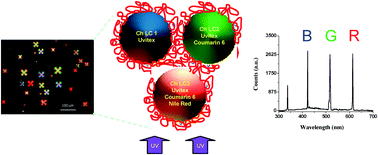Mixed emulsion of liquid crystal microresonators: towards white laser systems
Abstract
Microdroplet systems have attracted great interest because of their wide range of applications, easiness in processing and handling, feasibility in developing miniaturized devices with high performances and large flexibility. In this study, a stable emulsion based on different dye-doped chiral liquid crystal droplets has been engineered in order to achieve simultaneous omnidirectional lasing at different wavelengths. To obtain the mixed emulsion of dye doped Bragg onion-type microresonators the twofold action, as a surfactant and a droplet stabilizer, of the polyvinyl alcohol dissolved in water has been exploited. Multiple wavelengths lasing in all directions around the mixed emulsion is demonstrated. By water evaporation, a plastic sheet including different types of chiral droplets is also obtained, retaining all the emission characteristic of the precursor emulsion. A relevant feature is the large flexibility of the preparation method that enables an easy and full control of the lasing spectrum addressing white laser systems. However, the simplicity of the procedure based on a single-step process as well as the high stability of the mixed emulsion is a relevant result, envisaging strong potentiality for developing easy and friendly technologies useful in the field of identification, sensing, imaging, coating and lab-on-a-chip architectures.



 Please wait while we load your content...
Please wait while we load your content...